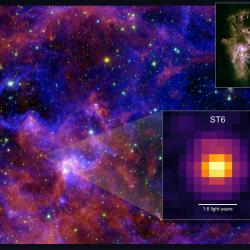A Nearby Exoplanet Reeks of Rotten Eggs—And That’s a Good Thing
Using the James Webb Space Telescope, UMD astronomers helped sniff out a stinky atmosphere that may offer clues about ‘gas giant’ planets.
An exoplanet infamous for its deadly weather has been hiding another bizarre feature—it reeks of rotten eggs, according to new data from the James Webb Space Telescope.
The atmosphere of HD 189733b, a Jupiter-sized gas giant, has trace amounts of hydrogen sulfide, a molecule that not only gives off a stench but also offers scientists new clues about how sulfur, a building block of planets, might influence the insides and atmospheres of gas worlds beyond the solar system.

The research team—which includes faculty members, students and alums from the University of Maryland’s Department of Astronomy—published its findings in the journal Nature on July 8, 2024. The study represents the first time that hydrogen sulfide, a “major molecule,” was detected in an exoplanet’s atmosphere, according to lead author Guangwei Fu (M.S. ’19, Ph.D. ’22, astronomy), an astrophysicist at Johns Hopkins University.
“We’re not looking for life on this planet because it’s way too hot,” Fu said, “but finding hydrogen sulfide is a stepping-stone for finding this molecule on other planets and gaining more understanding of how different types of planets form.”
First discovered in 2005, HD 189733b is considered a “hot Jupiter” exoplanet because it is large, gaseous and sticks close to its host star in orbit. It has scorching temperatures of 1,700 degrees Fahrenheit, which is hot enough to melt the silicate particles in the atmosphere and create “glass rain” that blows sideways on winds of 5,000 mph.
At only 64 light-years from Earth, HD 189733b is the nearest hot Jupiter that astronomers can observe passing in front of its star. Because of the exoplanet’s proximity to Earth and relatively large size compared with its host star, it was a “no-brainer” to study its atmosphere, said study co-author and UMD Astronomy Professor Eliza Kempton.
“When HD 189733b transits in front of its host star, it blocks out a fairly large fraction of the star’s light. This means that all of the atmospheric signals that we're looking for are going to be that much bigger and easier to see,” Kempton explained. “When Webb launched, we knew we'd get beautiful, exquisite data where you can see the full features of different molecules in the atmosphere."
Kempton first studied HD 189733b in 2008 when she was a Ph.D. student at Harvard. She and her collaborators used a Canadian space telescope “about the size of a suitcase” to observe the exoplanet as it passed in front of its host star. At the time, they were only able to measure the brightness of the star at wavelengths of light visible to the human eye, but everything changed with the advent of Webb and its infrared technology two years ago.
“Webb opened up this whole window into aspects of the atmosphere that we just didn't have the instrumentation or the telescopes back then to go out and see,” Kempton said. “It was fun to come back and study the atmosphere of HD 189733b, which is what I work on now and what has excited me for a long time.”
In addition to measuring the sulfur in HD 189733b’s atmosphere, the research team precisely characterized the main sources of the planet’s oxygen and carbon: water, carbon dioxide and carbon monoxide.
The new data also ruled out the presence of methane in HD 189733b with unprecedented precision and infrared wavelength observations from the Webb telescope, countering previous claims about that molecule’s abundance in the atmosphere.
As it did by detecting water, carbon dioxide, methane and other critical molecules in other exoplanets, Webb gives scientists yet another new tool to track hydrogen sulfide and measure sulfur in gas planets outside the solar system.
For Kempton, one of the most exciting parts of this ongoing research is learning how greatly hot Jupiters can vary.
“They’re a whole family of gas giant planets that orbit very closely to their host stars, but they're not identical, so that's where it's always kind of surprising,” Kempton said. “Which outcome are we going to get for this planet relative to the other ones that we've already looked at? We can't really predict it until we get a look at the spectrum.”
###
This article was adapted from text provided by Johns Hopkins University.
In addition to Kempton, co-authors of this study from UMD’s Department of Astronomy include Research Professor Drake Deming, Ph.D. students Jegug Ih and Arjun Savel (M.S. ’22, astronomy), and postdoctoral associate Matt Nixon.
Their paper, “Hydrogen sulfide and metal-enriched atmosphere for a Jupiter-mass exoplanet,” was published in Nature on July 8, 2024.
This research was supported by NASA through the JWST GO program. This article does not necessarily reflect the views of this organization.







